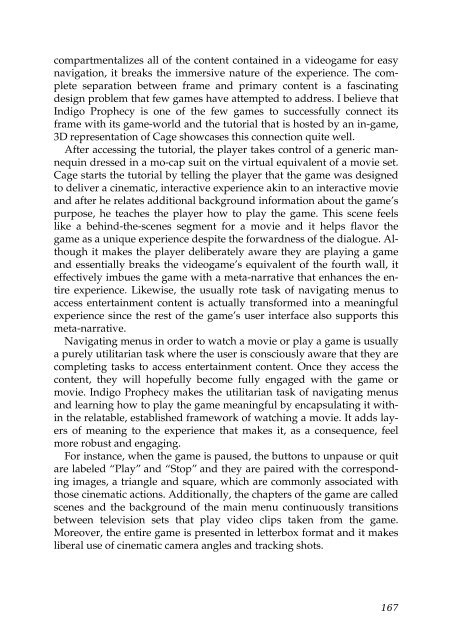Well Played 2.0: Video Games, Value and Meaning - OpenLibra
Well Played 2.0: Video Games, Value and Meaning - OpenLibra
Well Played 2.0: Video Games, Value and Meaning - OpenLibra
You also want an ePaper? Increase the reach of your titles
YUMPU automatically turns print PDFs into web optimized ePapers that Google loves.
compartmentalizes all of the content contained in a videogame for easy<br />
navigation, it breaks the immersive nature of the experience. The complete<br />
separation between frame <strong>and</strong> primary content is a fascinating<br />
design problem that few games have attempted to address. I believe that<br />
Indigo Prophecy is one of the few games to successfully connect its<br />
frame with its game-world <strong>and</strong> the tutorial that is hosted by an in-game,<br />
3D representation of Cage showcases this connection quite well.<br />
After accessing the tutorial, the player takes control of a generic mannequin<br />
dressed in a mo-cap suit on the virtual equivalent of a movie set.<br />
Cage starts the tutorial by telling the player that the game was designed<br />
to deliver a cinematic, interactive experience akin to an interactive movie<br />
<strong>and</strong> after he relates additional background information about the game’s<br />
purpose, he teaches the player how to play the game. This scene feels<br />
like a behind-the-scenes segment for a movie <strong>and</strong> it helps flavor the<br />
game as a unique experience despite the forwardness of the dialogue. Although<br />
it makes the player deliberately aware they are playing a game<br />
<strong>and</strong> essentially breaks the videogame’s equivalent of the fourth wall, it<br />
effectively imbues the game with a meta-narrative that enhances the entire<br />
experience. Likewise, the usually rote task of navigating menus to<br />
access entertainment content is actually transformed into a meaningful<br />
experience since the rest of the game’s user interface also supports this<br />
meta-narrative.<br />
Navigating menus in order to watch a movie or play a game is usually<br />
a purely utilitarian task where the user is consciously aware that they are<br />
completing tasks to access entertainment content. Once they access the<br />
content, they will hopefully become fully engaged with the game or<br />
movie. Indigo Prophecy makes the utilitarian task of navigating menus<br />
<strong>and</strong> learning how to play the game meaningful by encapsulating it within<br />
the relatable, established framework of watching a movie. It adds layers<br />
of meaning to the experience that makes it, as a consequence, feel<br />
more robust <strong>and</strong> engaging.<br />
For instance, when the game is paused, the buttons to unpause or quit<br />
are labeled “Play” <strong>and</strong> “Stop” <strong>and</strong> they are paired with the corresponding<br />
images, a triangle <strong>and</strong> square, which are commonly associated with<br />
those cinematic actions. Additionally, the chapters of the game are called<br />
scenes <strong>and</strong> the background of the main menu continuously transitions<br />
between television sets that play video clips taken from the game.<br />
Moreover, the entire game is presented in letterbox format <strong>and</strong> it makes<br />
liberal use of cinematic camera angles <strong>and</strong> tracking shots.<br />
167

















